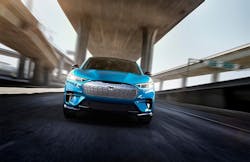If it wasn’t a shot heard ‘round the world, it was one that certainly resonated around the auto industry.
At the recent Los Angeles Auto Show, Ford unveiled its first significant expansion to the Mustang lineup in over half a century: an all-electric model named the Mach-E. That news promptly inspired a flurry of activity at Ford dealerships.
“The phone has been ringing, ringing, ringing,” says Bob Tomes, the president of Bob Tomes Ford in suburban Dallas. “In the first two weeks (after the Mach-E’s unveiling) we got 23 orders in the bank. A lot of other dealers in north Texas have taken some big orders.”
The new Ford all-electric crossover—which, according to a USA TODAY report, costs $44,000-$60,000 and which Tomes says could hit dealerships within 6 months—symbolizes automakers’ slow but steady shift toward electric vehicles.
TIME FOR DISRUPTION
In emailed correspondence with FenderBender, Ted Cannis, Ford’s global director of electrification, noted that “By 2025, we expect BEVs to grow to 8 percent of industry sales in the U.S. and to 15 percent in Europe.”
As a result, the Ford representative added: “We needed to disrupt ourselves.”
That explains the recent attention-grabbing reveal of the Mach-E, a compact SUV which Tomes says Ford customers are intrigued by due to power that’s rare for an EV (“It’s quiet, and runs 0 to 60 in less than 4 seconds,” the Texas auto dealer says) and a range that he says reaches around 300 miles on a single charge. Tomes, whose facility ranks among the top 2 percent of all U.S. Ford dealerships in terms of sales, also praised the Mach-E’s lithium-ion battery configuration and ability for frequent over-the-air updates.
“As the auto industry has continued to change,” Cannis noted in his email to FenderBender, “we’re focused on three things: Playing to our strengths, including pickups, performance vehicles and commercial vehicles; leaning into our iconic brands people already love; and leveraging the capabilities of electrification and new technology.
“We’re confident that, with the Mustang Mach-E, we will be able to achieve all of the above. … The Mustang Mach-E wholeheartedly rejects the notion that electric vehicles are only good at reducing gas consumption.”
While the Mach-E has drawn attention due to reports of uncommon power for an EV (Ford officials say the Mach-E GT Performance Edition boasts 459 horsepower), its ability to provide frequent over-the-air updates could truly become a trendsetter among non-luxury OEMs.
“Ford has outfitted the Mach-E with the ability to continuously improve through the delivery of secure over-the-air updates,” Cannis said in the aforementioned email, “... offering maintenance updates and even adding entirely new features. Many updates will be virtually invisible to customers, enabled by an industry-first innovative cloud and vehicle platform that keeps current software running until the new version is ready for activation—technology not even available in some popular smartphones.”
EVs’ ASCENT
As recently as 2018, EVs made up around 3 percent of all vehicles on roadways, according to various reports. But the time and work that Ford put in to rolling out the Mach-E suggests OEMs are beginning to openly embrace investing in a legitimate push toward widespread electrification.
Further evidence: Ford officials say they’re investing more than $11.5 billion in electrification in hybrids, plug-ins, and full battery electrics.
The combustion engine is here to stay for the foreseeable future, but has a growing competitor in the form of EVs.
Ford officials, for example, recently stated in a press release that they’re motivated to help consumers eventually shift to “an all-electric lifestyle.”
Tomes, a 37-year veteran of the auto industry, feels he has seen ample evidence of growing consumer interest in EVs.
“I think EVs are going to be a higher percentage than, heretofore, I was thinking― I think that 3 percent we had in 2018 is going to quickly be eclipsed. I think, in a relatively short time frame now, we’re going to see electric-powered vehicles come to the forefront.”

